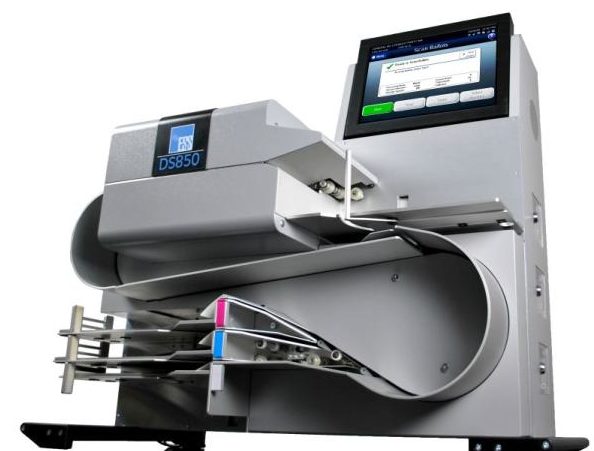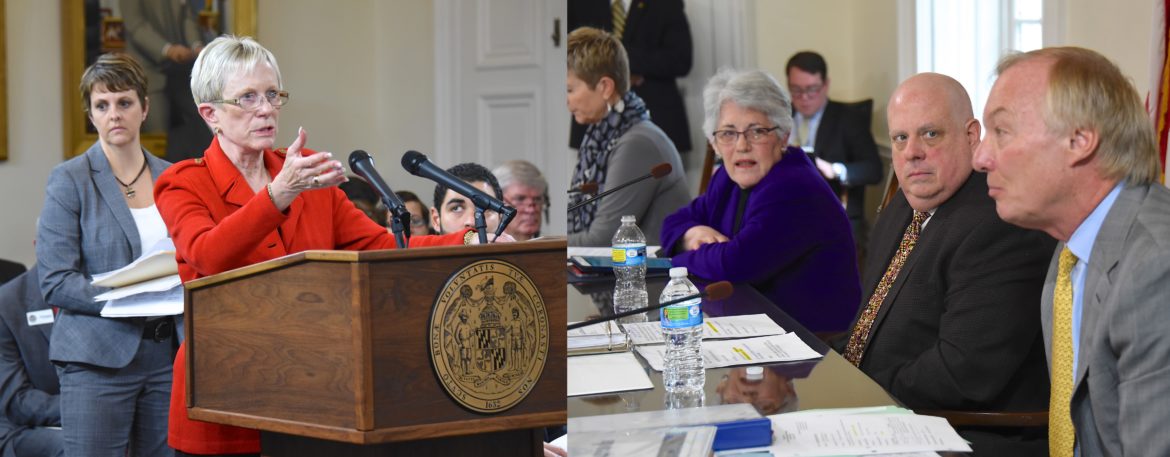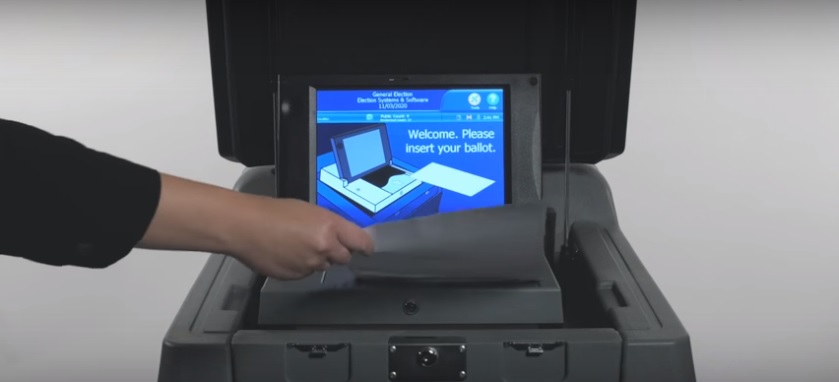By Glynis Kazanjian
For MarylandReporter.com

This sort of high speed scanner is supposed to be used to count absentee and provisional ballots. Photo from State Board of Elections website.
Baltimore’s troubled primary election could be blamed on delayed training materials for Maryland’s new paper ballot system and repeated revisions to a training manual for election judges. But it doesn’t explain why major voting irregularities took place in only one of Maryland’s 24 voting jurisdictions, while the rest of the state experienced nominal problems.
UPDATE 6/22/2016: There were some problems with missing absentee ballots in Montgomery County that emerged in a Senate hearing.
Baltimore City’s own elections director, who denies fraud or wrongdoing in the April 26 election, suggests that hundreds of election judges not showing up as scheduled, trouble recruiting quality judges and a lack of uniformity in general knowledge of procedures could be at issue. But plaintiffs in a federal lawsuit believe repeated negligence by top officials led to the problems.
Meanwhile, the governor’s office raised red flags about preparedness well before the election but were reassured that all was well.
Over 1,700 provisional ballots were improperly handled, and the lawsuit has been filed in federal court alleging voter fraud and gross negligence.
About 1,200 provisional ballots were scanned and included in vote tallies, even though those ballots were supposed to be counted only when the voter was deemed eligible to vote, a process that takes place separate from election day. Another 500 provisional ballots were supposed to be segregated to be included in a future count, if needed, but those ballots were temporarily misplaced.
There were few problems with provisional ballots in the rest of the state, a fact that plaintiffs in the Baltimore City lawsuit are emphasizing.
State Board of Elections probes ‘massive breakdown’
The chairman of the Maryland State Board of Elections, David McManus, a Republican, has requested the names of each of the judges who worked in the troubled Baltimore City precincts where the largest irregularities occurred, and said staff told him records with the names exist and are forthcoming.
“It’s understandable if a couple of provisional ballots slip through,” McManus said. “What’s not acceptable is that at some Baltimore City precincts every single provisional ballot was scanned. That’s a massive breakdown of some sort. We know what happened and where it happened, but we don’t know why yet.”
Preliminary election reports from May indicated at least 100 of Baltimore’s 296 precincts scanned provisional ballots during the election, even though none were supposed to be scanned then. Those ballots should have been counted only after state elections officials determined the voter was eligible — a process that is designed to happen during a designated canvass period.
Nine precincts scanned 50% or more of their provisional ballots and one precinct both scanned some ballots and segregated others. The Public Safety Training Center early voting site also scanned 67 of 346 provisional ballots cast.
Lawsuit filed in federal court
A lawsuit was filed in federal court last week by Members of Voters Organized for the Integrity of City Elections (VOICE), and other plaintiffs, seeking to have the primary results voided and the election redone. They alleged voter fraud and voter disenfranchisement. Just a few of the problems noted in the suit include polls opening late, voters being sent away, multiple ballots being handed out and the provisional ballot problem.
State Election Administrator Linda Lamone and Baltimore City Elections Director Armstead Jones are named as defendants.
Jones said Thursday that 351 election judges did not show up for work on primary day. He has publicly denied any wrongdoing or allegations of fraud. Previous election coverage shows this to be a persistent problem in Baltimore, where Jones has been elections director since 2007, and head of the city elections board before that.
When asked about the problem with the provisional ballots, Jones said that’s one question he keeps asking himself. “That process did not change,” he said. “That’s not what we teach them in training. The University of Baltimore provides excellent training for the city’s election judges.”
Jones said he thinks the concept of having two ballots that look the same creates confusion, along with the installation of a brand new voting system.
“You have to understand the caliber of people we are talking about,” Jones said. “In most cases in our precincts, if we have seven people there to work maybe two people basically know what to do.”
“You have to understand the caliber of people we are talking about,” Jones said. “In most cases in our precincts, if we have seven people there to work maybe two people basically know what to do.”
The State Board of Elections may also have to answer for its negligence. The state switched to a paper ballot system for the 2016 elections. In January 2015, the state election board said its goal was to have all the training materials for the new voting system ready by June 30. When June came and went, the new goal was to have all of the training materials ready by a mock election in October — but the revisions continued.
Lamone reassured Hogan on election technology

State Elections Administrator Linda Lamone testifies Dec. 2, 2015 to the Board of Public Works made up of, from right, Comptroller Peter Franchot, Gov. Larry Hogan, Treasurer Nancy Kopp. Photos by Joe Andrucyk, Governors Office.
Matt Clark, spokesman for Gov. Larry Hogan, said the administration raised flags early on and was told at the time there was nothing to be concerned about.
“In October the governor raised a number of concerns about the state’s preparedness for the primary election,” Clark said. (Lt. Gov. Boyd Rutherford raised issues on Oct. 7 at the Board of Public Works, page 100 of the transcript.)
“The Department of Information Technology also expressed concerns at a Board of Public Works meeting,” Clark said.
Both times the governor was given reassurances the state would be prepared, Clark said.
At the Dec. 2 meeting of the Board of Public Works (transcript, page 48), Hogan and Comptroller Peter Franchot brought up issues about the technology of the new system based on information from the Department of Information Technology. Lamone reassured them about the new system, though Hogan was dubious.
Yet none of the key problems in the Baltimore election are about the technology, but about how paper ballots were handled.
Late training materials, revised election judge guidelines
Election officials in Montgomery County, the largest voting jurisdiction in the state, said all of the training resources from the state were supposed to be finalized before a statewide mock election was held last October. However, most of the forms and chapters of the election judge training manual were provided in December with changes occurring as late as February 2016.
“Training was delayed from the start,” said Montgomery County Deputy Elections Director Alysoun McLaughlin. “A lot of changes had to be incorporated on the fly.”
In January 2016, Montgomery opted to use software from the City of Rockville’s nonpartisan elections because updated software needed to train judges on electronic polling books had not yet arrived from the state. Those final poll books didn’t come until the second week of February, McLaughlin said.
“We were not able to do hands-on training for election judges who attended the earlier classes on how to issue a provisional ballot for a voter who claimed to be registered with a different political party,” McLaughlin said. “We had to explain it.”
The final version of the training manual was mailed the last week of February to election judges who had already been trained. Montgomery trained approximately 3,000 election judges. In Baltimore, Jones said he targeted 2,100 election judges to train.
Montgomery trained approximately 3,000 election judges. In Baltimore, Jones said he targeted 2,100 election judges to train.
“A lot of regulations and procedures had to be rewritten and supplies had to be procured, and while the voting equipment is new, the electronic poll books that had software that needed to be modified are a decade old,” McLaughlin said. “Overall, the election went very well, and the State Board of Elections deserves a lot of credit for that.”
Another change that occurred, was a decision made in February to forego the use of newly purchased electronic ballot marking machines for early voting because of a computer glitch that could not be remedied in time. It would cause the state to print a variation of ballots that would add expenses and another change to election judge manuals.
Lawsuit plaintiff calls elections director a liar
One of the lawsuit’s plaintiffs, Hassan Giordano, a Baltimore campaign consultant, blogger and criminal justice chairman of the Baltimore NAACP, said he thinks voter fraud could have occurred in the primary election. But, he blames election day problems on the “repeated negligence” of Baltimore’s elections director, Jones.
“I think it may have been a mixture of both, but more so it was gross negligence on behalf of Armstead Jones of the Baltimore City Board of Elections,” Giordano said. “When you look at it, we had a new system, not just in Baltimore, but across the state. What’s really eye-opening is that 23 other jurisdictions combined only had roughly 200 instances throughout the state in terms of provisional ballots, whereas Baltimore City had eight times that – 1,700 by itself.”
Giordano said it is also not believable that hundreds of judges simply did not show up for work the morning of the primaries.
“That’s a lie,” Giordano said. “First [Jones] blamed it on 300 judges not showing up, but then it dawned on me, that’s a very large number of volunteers who signed up to work and not get paid. A week later, [Jones] said it might not have been 190 something. ‘I was just guesstimating,’” he said.
The State Board of Elections can no longer publicly comment on the Baltimore City primary election because of the lawsuit. However, spokeswoman Donna Duncan provided an excerpt from the January 2016 meeting minutes of the board’s monthly meeting:
“Election Judges’ Manuals[.] The election day manual is complete. As the local boards submit their customized chapters, Ms. Perrone reviews each chapter for approval. Instructions and forms for election judges working during early voting are being proofed and will be ready for modification by January 22nd. Instructions for same day registration and address changes are being reviewed and updated to reflect changes in the pollbook software.”





The Baltimore City Board of Elections and not the State Board of Elections should be held responsible for what happened… They chose the people who were the election judges and approved them and this stuff happened…
I wrote in an earlier post about my training as an election judge in Baltimore County this year. The county was organized and disciplined in instructing all of we judges and I felt that I could carry out my duties. ( I was a judge in 2012 & 2014…)
The reason the state changed to the paper ballot was due to the whining over having a “paper trail” and the ” tin foil hat” conspiracy theories about machines already having votes in them, changing votes from one party to another, etc.
( And these same people want Internet voting… ? )…
As I mentioned above, I worked as a judge in 2012 and 2014 and I worked with the electronic voting machines…
Before the polls opened, every machine and poll books were checked out and if anything was amiss, that machine was put aside and noted…
There was a huge paper trail created between the opening machine reports, voter access cards, the vote tallies from each machine…
But, the whiners never considered this…
And the residents of Baltimore City should sue themseleves for being incompetent ! Not the State…
You simply do not understand what a “paper trail” is. The electronic machines had no paper record of the voter’s choices. The voter could never verify that the choices made on the touchscreen were correctly recorded by the software. Now, we have a real paper trail, a permanent record on paper, verified by the voter who marked it, that cannot be altered by bugs in the software or by hacking. This real paper trail allows us to do proper recounts, if necessary, and to check the accuracy of the electronic tallies from the scanners by doing hand-count audits of the paper ballots.
And in Baltimore City’s case, paper ballots were misplaced as well as the memory sticks from the machines… Some of the machines even went missing !
As for your position regarding the voter not being able to verify their choices on a touch screen… With the touch screen, you had the option to review your choices and was reminded of selections not made so that you could make the choice before casting the ballot… And of a voter can’t do that then… Maybe they shouldn’t vote…
Also, the ballots in either case are anonymous so how would anyone be able to find their paper ballot ?
There were memory sticks with the electronic ballot machines as well…
Every hour, the voter access card receipts at the electronic machines were collected at each machine and placed in bundles of 25 ( Republican and Democrat ) and kept with the machines in manila envelopes…
So, there was a “1 to 1” correlation…
BTW, I support voter ID…
Getting back to the primary…
People also forgot to mark both sides of the ballot… The delegates were to be elected as well as the candidates…
I was the Republican ballot judge, giving ballots to Republican voters and I reminded them about choosing the delegates as well as the Presidential candidates…
You wouldn’t believe how many people actually didn’t read the ballot instructions as to marking the it choices ! I received “spoiled” ballots with check marks, “x’s”, candidate names circled… I also was asked why there were “so many” choices…
I can’t wait until we have bond issues, proposed laws, etc. on the ballots…/sarc
It is ironic that those who have issues with electronic ballots use smartphones, ATM’s, credit card terminals, order things on line…
Again, it was the Baltimore City Board of Elections incompetence that created the problems that the city had…
I agree that poor training and incompetence were the fault in Baltimore City. BTW, the same thing happened on a smaller scale in many places across the state, so it was not just Baltimore City poll judges who were incompetent. My main concern is that people understand why we changed to paper ballots as an inherently superior system of voting. When you mark a paper ballot you able to verify that the marks on the ballot accurately record your intentions. That is proper verification of your recorded vote. When you vote on a touchscreen you cannot see how your vote is recorded. It is recorded by invisible software inside the computer. You have to blindly trust that the software does not have a defect (as has been documented many times in elections) or that a malicious program has not been inserted into the system to change your vote or the way it is being counted. This is the essential difference and we should always remember this. The poorly executed procedures in this election can happen with any type of system, but paper ballots have the unique ability of being able to be recounted without the need for invisible software.
But, the ballot machines also use “invisible software” to read read the ballots and record the votes, and there are ” memory sticks” that also record the votes of the ballots scanned…Also powered by “invisible software”…
And pre-marked ballots can be scanned into the machines, thus possibly affecting votes… And, they can be counted !
Do the names : Chicago and Cook County, Illinois ring any bells regarding vote fraud ?
Thousands of pre-marked ballots miraculously appeared and also were found in warehouses…
So much for paper ballots…
Again, I have served as an election judge in 3012, 2014, and 2016 and am very familiar with voter machine or ballot integrity and security and in each election, I never discovered any tampering of the machines in my precinct…
BTW, the equipment was locked away in a very secure room, then moved to the polling place in the same building…
Again, I’ll stack my experience against the “tin foil hat” conspiracy theories of those too lazy to do their own research…
It’s also ironic that those who espouse those theories regarding “software and programming” use computers and smartphones…